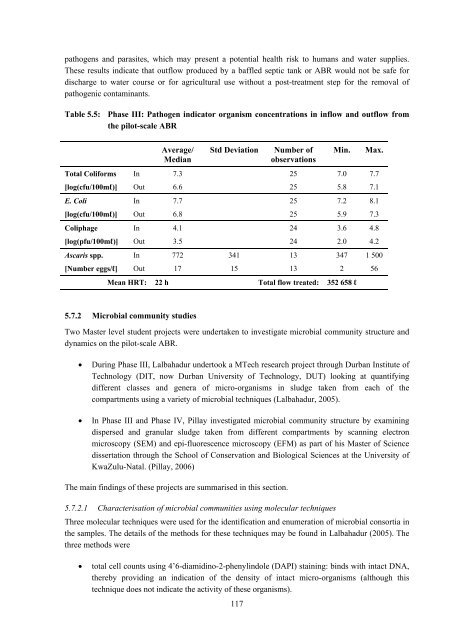analysis of a pilot-scale anaerobic baffled reactor treating domestic ...
analysis of a pilot-scale anaerobic baffled reactor treating domestic ...
analysis of a pilot-scale anaerobic baffled reactor treating domestic ...
You also want an ePaper? Increase the reach of your titles
YUMPU automatically turns print PDFs into web optimized ePapers that Google loves.
pathogens and parasites, which may present a potential health risk to humans and water supplies.<br />
These results indicate that outflow produced by a <strong>baffled</strong> septic tank or ABR would not be safe for<br />
discharge to water course or for agricultural use without a post-treatment step for the removal <strong>of</strong><br />
pathogenic contaminants.<br />
Table 5.5: Phase III: Pathogen indicator organism concentrations in inflow and outflow from<br />
the <strong>pilot</strong>-<strong>scale</strong> ABR<br />
Average/<br />
Median<br />
Std Deviation Number <strong>of</strong><br />
observations<br />
117<br />
Min. Max.<br />
Total Coliforms In 7.3 25 7.0 7.7<br />
[log(cfu/100mℓ)] Out 6.6 25 5.8 7.1<br />
E. Coli In 7.7 25 7.2 8.1<br />
[log(cfu/100mℓ)] Out 6.8 25 5.9 7.3<br />
Coliphage In 4.1 24 3.6 4.8<br />
[log(pfu/100mℓ)] Out 3.5 24 2.0 4.2<br />
Ascaris spp. In 772 341 13 347 1 500<br />
[Number eggs/ℓ] Out 17 15 13 2 56<br />
Mean HRT: 22 h Total flow treated: 352 658 ℓ<br />
5.7.2 Microbial community studies<br />
Two Master level student projects were undertaken to investigate microbial community structure and<br />
dynamics on the <strong>pilot</strong>-<strong>scale</strong> ABR.<br />
• During Phase III, Lalbahadur undertook a MTech research project through Durban Institute <strong>of</strong><br />
Technology (DIT, now Durban University <strong>of</strong> Technology, DUT) looking at quantifying<br />
different classes and genera <strong>of</strong> micro-organisms in sludge taken from each <strong>of</strong> the<br />
compartments using a variety <strong>of</strong> microbial techniques (Lalbahadur, 2005).<br />
• In Phase III and Phase IV, Pillay investigated microbial community structure by examining<br />
dispersed and granular sludge taken from different compartments by scanning electron<br />
microscopy (SEM) and epi-fluorescence microscopy (EFM) as part <strong>of</strong> his Master <strong>of</strong> Science<br />
dissertation through the School <strong>of</strong> Conservation and Biological Sciences at the University <strong>of</strong><br />
KwaZulu-Natal. (Pillay, 2006)<br />
The main findings <strong>of</strong> these projects are summarised in this section.<br />
5.7.2.1 Characterisation <strong>of</strong> microbial communities using molecular techniques<br />
Three molecular techniques were used for the identification and enumeration <strong>of</strong> microbial consortia in<br />
the samples. The details <strong>of</strong> the methods for these techniques may be found in Lalbahadur (2005). The<br />
three methods were<br />
• total cell counts using 4’6-diamidino-2-phenylindole (DAPI) staining: binds with intact DNA,<br />
thereby providing an indication <strong>of</strong> the density <strong>of</strong> intact micro-organisms (although this<br />
technique does not indicate the activity <strong>of</strong> these organisms).
















